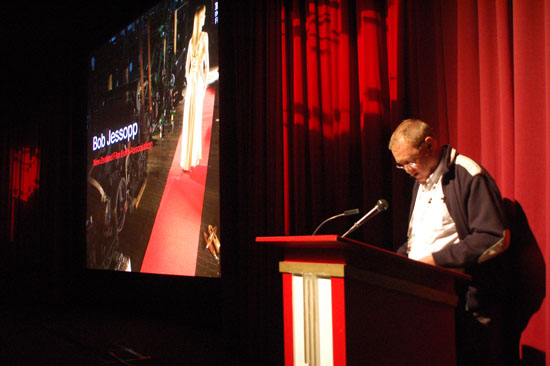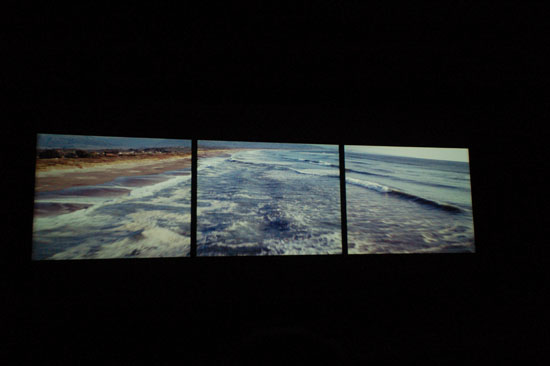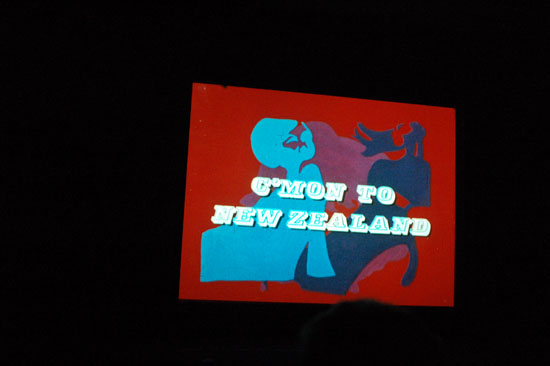"This is New Zealand" introduction |
Read more
at in70mm.com The 70mm Newsletter |
| Written by: Bob Jessopp & Edited by Hugh Macdonald The Director) | Date: 11.04.2009 |
 Good Morning Ladies & Gentlemen Welcome to “New Zealand’s” contribution to the wide screen weekend. Good Morning Ladies & Gentlemen Welcome to “New Zealand’s” contribution to the wide screen weekend.Tena koto, Tena Koto, Tena Koto, Katoa. Welcome. Here is a little background information to New Zealand’s one and only 3 camera, 3 projector wide screen Film Production. The New Zealand ‘National Film Unit’ was established at the start of World War Two to produce newsreels to inform New Zealanders of the war effort at home and abroad. It continued making films to promote New Zealand and its films have won many International awards. The National Film Unit or NFU ceased production in 1989 and was sold to Television New Zealand. From whom Peter Jackson purchased and rebuilt the film laboratory and sound mixing facilities in 1999. Returning to 1968 The government determined that New Zealand would participate at Expo 70 in Osaka, Japan. New Zealand had lost its favored market position in the UK as a result of Britain having joined The European Common Market, and it had to find new trading partners. |
More
in 70mm reading: “Broadsword Calling Danny Boy” Widescreen Weekend Report 2009 WSW 2009 program Widescreen Weekend Home Mr. Derren Nesbitt ("Major von Hapen" in "Where Eagles Dare") Lost Orphaned Films Abandoned in Basement The History of 70mm Short Subjects Ramon's WSW review and Audience feedback Images: Friday, Saturday and Sunday "Audience on Stage" and Academy of the Wide Screen Weekend Film Introductions: "The Bible...in the beginning" "How the West Was Won" "Khartoum" "The King and I" "West Side Story" "Faubourg 36" 70mm in Paris "This is New Zealand" 3-strip EXPO Film From New Zealand The M.C.S.-70 Process |
 Early concepts for the New Zealand Pavilion at Expo 70 were a series of static industrial and primary produce displays. Geoffrey Scott the then Manager of the N F U advised that he could portray New Zealand far better with 20 minutes of film, than could ever be done with model sheep and cows. Jack Marshal the minister of Tourism, Industry and Commerce agreed, and gave government support. Early concepts for the New Zealand Pavilion at Expo 70 were a series of static industrial and primary produce displays. Geoffrey Scott the then Manager of the N F U advised that he could portray New Zealand far better with 20 minutes of film, than could ever be done with model sheep and cows. Jack Marshal the minister of Tourism, Industry and Commerce agreed, and gave government support.The NFU did not have the resources to make a 70mm split screen film so a decision was made to create a three strip production, adapting conventional 35 mm film equipment. Three mechanically interlocked 35 mm Arriflex 2C cameras, were mounted on a tripod with one angled to the left, one straight ahead and the third angled to the right for the composite 3-screen shots. Two Nagra tape recorders synchronized by beeps, rolled together to record stereo atmospheres. Three interlocked 35mm projectors projected the images on to a 3 panel screen. The sound was mixed to three channels and was reproduced from a separate 3 track 35mm magnetic sound reproducer. |
Internet link: |
 The 3 camera rig was used for the composite 3-screen panoramas and aerials, and 3 camera crews, each with an Arriflex 2c, shot new single-screen images over a 6 month period. Director Hugh Macdonald and his team made full creative use of the split screen process by combining all this new footage into a seamless wide screen production. The 3 camera rig was used for the composite 3-screen panoramas and aerials, and 3 camera crews, each with an Arriflex 2c, shot new single-screen images over a 6 month period. Director Hugh Macdonald and his team made full creative use of the split screen process by combining all this new footage into a seamless wide screen production.New Zealand at that time had no colour processing facilities so the footage was sent to Humphries Laboratories in London. The turn round time for the colour workprint to arrive back in Wellington was 6 weeks, leaving no time for mistakes…. The final production exhibited at Expo 70 ran 21 times every day for 6 months, a total of some 3,843 performances and proved a resounding success. So much so, that when the film and equipment came back to New Zealand it was put on road show in the four main centers to further audience acclaim. Since the disposal of the National film unit, the negatives have remained at Archives New Zealand until Allan Honey an ex-Television New Zealand engineer, who had seen the film as a child, persuaded Hugh Macdonald to loan him a set of prints. The prints were digitized and the three images combined onto a DVD. |
|
 This test DVD was screened to Archives New Zealand who were enthusiastic but it wasn’t until mid 2006 with the arrival of English film archivist David Smith at Archives New Zealand that a proposal to restore the film to a single-strip CinemaScope image was given the green light. This test DVD was screened to Archives New Zealand who were enthusiastic but it wasn’t until mid 2006 with the arrival of English film archivist David Smith at Archives New Zealand that a proposal to restore the film to a single-strip CinemaScope image was given the green light.Archives New Zealand commissioned Peter Jackson’s “Park Road Post Production Facilities” for this demanding technical task, which was done using the new Digital Intermediate process. Director Hugh Macdonald, Sound Designer Kit Rollings and David Smith oversaw the DI process and the cleanup and the remix of the sound from 3 tracks to full Dolby 5.1. ambience In 2007, the new composite print ran to sell-out audiences at New Zealand Film Festivals, and also won a Bronze Medal that year at the New York Film Festival - in the Multiple Image category. Not bad for a film approaching 40 years of age. With thanks to Archives New Zealand, here for you today is the film programme as shown to New Zealanders on it’s return from Osaka Japan. Sit back and enjoy once again a film that thrilled audiences over two generations ago. Ladies and Gentlemen, "Expo 70" and "This Is New Zealand" |
|
|
Go: back
- top - back issues
- news index Updated 22-01-25 |
|
